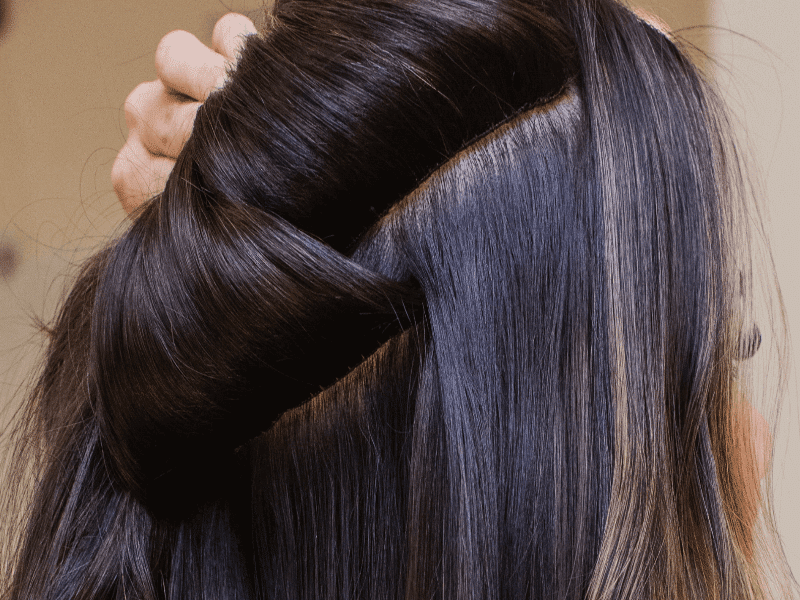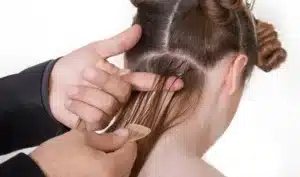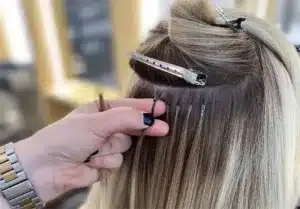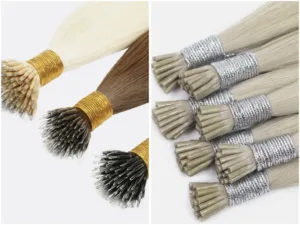You want longer, fuller hair that stays beautiful. But you worry about constant salon visits and hidden damage.Ever wondered how long those beautiful hand-tied hair extensions last? Get clear, simple facts in one place.
Hand Tied Extensions,for most people need a move up every 6–10 weeks. Hair lifespan depends on quality and care: non-Remy 1–3 months, Remy 4–6 months, full-cuticle 1year months with proper care. Gentle routines and timely maintenance extend wear.

This guide explains everything in plain language. It covers time between appointments, how long the hair itself lasts, what helps or harms it, safe washing, and real value. Use it to plan with confidence.
How Long Does Hand Tied Extensions Last?
Waiting too long to move up can cause slip or tension. Moving up too soon wastes time and money. The right window matters.
Most installs need a move up every 6–10 weeks. Hair lifespan is separate: non-Remy 1–3 months, Remy 4–6 months, full-cuticle 12–24 months with proper care and moderate heat.

Dive deeper
Move up time vs. hair lifespan
“Move up” means the stylist lifts and re-secures the weft after natural hair growth. Growth pulls rows lower over time. A 6–10 week window keeps rows stable and comfortable. People with fast growth, frequent workouts, or oilier scalps lean closer to 6–8 weeks. Others fit 8–10 weeks.

“Hair lifespan” is how long the hair itself looks and feels good across many move ups. This depends on hair quality, color level, heat exposure, and daily care. Ultra-light blond shades usually sit at the lower end because bleaching stresses the fiber. Dark or medium shades often last longer.
| Item | What it means | Typical timing |
|---|---|---|
| Move up | Reposition rows as hair grows | Every 6–10 weeks |
| Hair lifespan | Total months the hair stays reusable | 1–24 months (quality + care) |
| Fast growers | Hair drops earlier | Rebook sooner |
| Very light blondes | More fragile fiber | Shorter top end |
If someone asks, “how long does hand tied extensions last,” give a two-part answer: “Move up every 6–10 weeks; with top-quality hair and good care, expect many months to even a year or more.”
What determines the lifespan of hand tied extensions?
Not all hair is the same. The starting material and the way it is processed set the ceiling for longevity.
Full-cuticle, single-donor hair lasts the longest. Gentle, controlled processing protects the cuticle. True hand-tied construction keeps the weft thin and smooth, which reduces friction at the base and helps long-term wear.
Dive deeper
Hair origin and structure
Single-donor ponytails with aligned cuticles resist tangling and dryness. Mixed hair from many sources often points in different directions, so cuticles rub against each other and cause friction. Aligned cuticles sit like roof shingles and slide smoothly.
Processing choices
Acid baths and heavy silicone coatings can hide damage at first, but performance drops after a few washes. Better factories use lower heat, careful pH, and extra time to reach color without burning the cuticle. High-lift blond is possible, but safer processing accepts lower output to protect the fiber.
Weft construction
A true hand-tied weft is thin and flexible. It usually has little or no “return hair” poking up from the stitch line, so it feels flat and comfortable. Even density (double-drawn) keeps the ends strong, which reduces trimming at each move up and protects lifespan.
| Factor | What to look for | Why it helps |
|---|---|---|
| Donor type | Single-donor, aligned cuticles | Less tangling and dryness |
| Chemical load | Gentle, controlled processing | Stronger cuticle plates |
| Color target | Moderate lift when possible | More elastic hair shaft |
| Weft build | Thin, true hand-tied track | Flat base, less friction |
| Length uniformity | Double-drawn density | Ends stay full longer |
What affects lifespan during install and daily wear?
Great hair can still underperform if the install is too tight or home care is rough. Small habits make a big difference.
Balanced tension, clean sections, and silicone-lined beads help at install. At home, gentle brushing, smart washing, full base drying, and moderate heat extend wear by months.
Dive deeper
During install
Anchors need enough of your natural hair to carry the weight. Too little hair increases pull. Too much hair can slip. Rows should avoid fragile edges and crown swirls. Silicone-lined beads cushion pressure. Weight should spread along the row rather than stack in one spot.

Daily care
Brush morning and night with a loop or soft-bristle brush. Hold the row at the base as you detangle from ends upward. Wash 2–3 times a week with sulfate-free shampoo. Rinse well. Apply conditioner from mid-shaft to ends, not on the beads. Dry the base fully after each wash. Sleep with a loose braid and use a silk pillowcase.
Heat and water
Use a heat protectant. Keep tools around 355–375°F (180–190°C). One slow pass beats many fast passes. Before swimming, wet hair with tap water and add a little conditioner to the ends. Rinse after and dry the base.
| Action | Why it helps | Simple rule |
|---|---|---|
| Hold base when brushing | Protects anchors | Two hands, start at ends |
| Dry base after wash | Prevents odor and slip | Base fully dry every time |
| Moderate heat | Reduces cuticle stress | Protectant + mid temps |
| Night braid + silk pillow | Lowers friction | Habit every night |

Do hand tied extensions damage your hair?
Fear of damage is common. The goal is beauty without harm.
Hand-tied extensions do not harm healthy hair when tension is light, move ups are on time, and removal is professional. Risks rise with tight installs, missed appointments, harsh products, or DIY removal.
Dive deeper
Damage is usually mechanical. Tight rows put steady pull on the same follicles. Overdue rows drop and tangle near the base. Rough brushing catches stitches. Chemical stress is the other part. Frequent high-lift blonding and very hot tools dry the fiber. Good screening matters. Fine edges need lighter density. Active scalp issues should calm before an install. A simple routine prevents most problems: book the next move up, brush gently twice a day, wash with care, and keep the base dry.
| Risk | Early sign | What to do |
|---|---|---|
| Excess tension | Tender spots | Adjust density and tension |
| Migration/slip | Beads visible | Rebook and refit rows |
| Base tangles | Snag near stitch line | Professional detangle only |
| DIY removal | Broken hairs | Always remove in salon |
Can you shower with hand tied extensions?
Some people hear “do not wash.” That is not correct and can create new issues.
Yes. Brush before showering, wash 2–3 times a week, keep conditioner off the anchors, and dry the base fully. Clean bases last longer and feel comfortable.
Dive deeper
Detangle first while holding the base. Use lukewarm water and a sulfate-free shampoo. Smooth shampoo in a straight, downward motion. Do not pile hair on top of your head. Rinse until the water runs clear. Apply conditioner mid-shaft to ends and comb through with fingers. Rinse well. Gently press out water with a towel. Blow-dry the base on medium heat until fully dry. Finish with cool air for shine. Apply a light serum to the ends if needed. Do not sleep with a damp base. This simple routine keeps rows fresh, reduces odor, and prevents slip.
| Do | Don’t | Reason |
|---|---|---|
| Brush and hold base | Tug from the root | Protects anchors |
| Shampoo scalp and base | Rub in circles | Avoids knots |
| Condition lengths only | Condition at beads | Prevents slippage |
| Dry base fully | Air-dry base | Stops odor and loosening |
Are hand tied extensions worth it?
You want value that lasts, not a quick win that fades fast.
They are worth it when you choose higher-quality hair, keep a steady move up rhythm, and follow simple care. You get a flat, natural look, flexible styling, and months of reuse.
Dive deeper
Hand-tied wefts sit very flat, so ponytails and half-up styles look natural. With better hair, you reuse the same wefts across many move ups. That spreads the upfront cost across many months. If you prefer heat styling, use a protectant and moderate temperature. If you love swimming or the gym, you can still enjoy extensions with a few extra habits: pre-wet before the pool, rinse after, and dry the base. Plan move ups on a calendar so rows never drop too far. A small routine gives long, reliable wear.
| Choice | Short-term feel | Long-term value |
|---|---|---|
| Low-grade hair | Looks good first weeks | Fades fast; more replacement |
| Mid-grade Remy | Good with care | Moderate reuse |
| Full-cuticle | Best feel and shine | Long reuse; lowest cost per wear |
How can you extend the lifespan of hand tied extensions?
A few steady habits add months of life. Consistency beats complicated routines.
Follow a 4-step plan: rebook on time, use gentle products, control heat, and reduce friction. These steps are easy and effective for most people.
Dive deeper
Set your next move up before you leave the salon. This stops late refits and protects the base. Use a sulfate-free shampoo and a light conditioner for the lengths. Add a leave-in with heat protection when you style. Keep heavy oils and masks away from the anchors. Heat tools work best at mid temperatures with one slow pass. At night, braid loosely and sleep on a silk pillowcase. During travel, pack a small brush and a mini heat protectant. Before swimming, wet hair with tap water, add a touch of conditioner to the ends, and rinse after you get out. Dry the base. These simple moves support both comfort and beauty.
| Task | How often | Quick tip |
|---|---|---|
| Move up | Every 6–10 weeks | Put it in your calendar |
| Wash | 2–3× per week | Rinse well; no conditioner at beads |
| Brush | Morning and night | Hold base; start at ends |
| Mask (lengths only) | Every 2–3 weeks | Extra moisture for blondes |
| Clarify (if needed) | About monthly | Follow with hydration |
My opinion
The biggest difference in real life comes from starting quality and simple, steady care. Full-cuticle, single-donor hair with gentle processing gives the softest feel and the strongest cuticle. That base lets you reuse hair across many move ups. Keep heat moderate, keep the base dry, and book on time. Most people then enjoy long wear with a natural look and less stress.

FAQ
Is the schedule different for very light blondes?
Often yes. Light blond has more processing, so keep heat lower, use richer masks, and expect the shorter end of the range.
Do hand-tied wefts shed more?
When the track is not cut, shedding is low. Avoid cutting the weft. Stack multiple wefts for fullness.
What brush should you use?
Use a loop or soft-bristle brush. Hold the base while brushing to protect the anchors.
Will extensions cause hair loss?
Not when tension is light and move ups are on time. Tight installs, overdue rows, or DIY removal raise risk.
Can you color the extensions?
Toning is safer than lightening. High-lift on extensions shortens lifespan.
How many rows do most people need?
Two rows suit many heads. A third row adds extra length or fullness.
Can you air-dry?
You can air-dry the lengths, but always blow-dry the base to prevent slip and odor.
What is the simplest daily routine?
Brush twice, wash 2–3× weekly, condition mid-shaft to ends, keep heat moderate, and sleep in a loose braid.
Conclusion
Hand-tied extensions are more than a mere addition to your beauty routine – they are an embodiment of individuality, flair, and self-expression.Book move ups every 6–10 weeks, choose better hair, and follow simple care. These three steps give longer wear, comfort, and a natural look. Just as every person has a unique story, so does every strand of these extensions.As you embark on this journey, let the charm of hand-tied extensions weave tales of poise, grace, and unabashed self-love. Celebrate the allure, celebrate yourself!
where to buy Handtied weft hair extensions
Hibiscus Hair Manufacturer has been dedicated to producing high-quality hair extensions for 25 years and is a recognized leader in the industry. If you are interested in finding a reliable hair extensions supplier and wholesale for your brand, please visit our website for more information:
Hand tied Weft Hair Extensions




